A Guide to Carriage House Plans
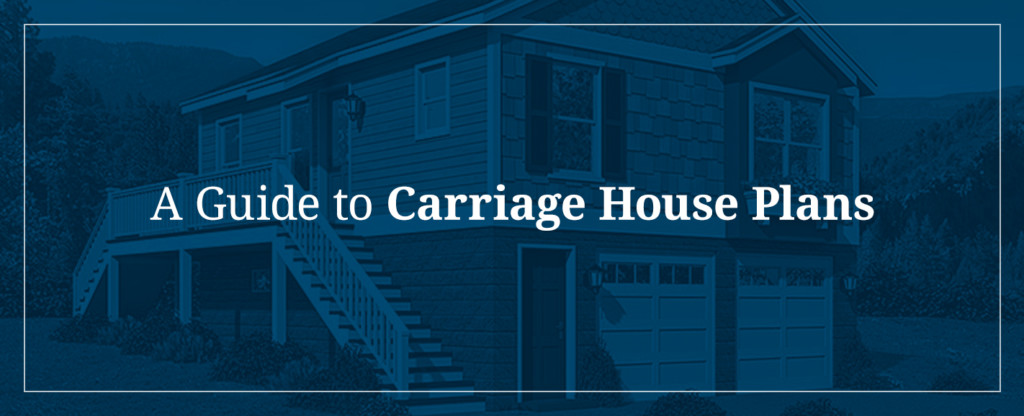
A carriage house — also known as a coach house — is a vintage necessity from the time before automobiles became common. These structures were found in both urban and rural areas, had architecturally simple to ornate designs and often performed double duty as living quarters as well.
As the horse-drawn carriage was phased out by motorized vehicles, carriage houses became unnecessary. However, instead of demolishing these buildings, many people repurposed them for modern uses.
Today, original carriages houses are coveted homes, but since they aren’t as common anymore, many people who want the charm of a carriage house build their own. These carriage homes are new structures that resemble carriage houses but have always been used as single-family dwellings. Others use historic carriage house plans to build detached garages that provide extra storage or living areas.

What Is a Carriage House?
Originally, a carriage house was essentially what we’d call a detached garage today. It was meant to house the horse-drawn carriage — although the horses were usually stabled elsewhere — and usually was a luxury enjoyed by the very wealthy.
These carriage houses sometimes also featured built-in living quarters for staff, such as grooms or coachmen and their families. While the animals were usually kept in a separate barn, some people were wealthy enough to have large carriage houses that could house the carriage, the animals and the staff and still have room for storage.
With the onset of the automobile, these carriage houses naturally transitioned to become garages, with the living quarters going to chauffeurs and other staff. A family’s wealth and their location dictated how elaborate the carriage house would be — cramped, urban homes tended to have smaller carriage houses while rural homes could afford to have carriage houses situated a fair distance from the main house and be as large as needed. Families built their carriage houses in the same design as the main house, signaling the detached building’s relation to the main house.
Today, when someone refers to a carriage house, they mean a detached garage that often has at least one living space on the second floor. While the term “carriage house” technically only refers to those structures that once housed carriages, it’s now fairly commonly used to describe a detached garage with living quarters — especially those designed to mimic traditional carriages houses.
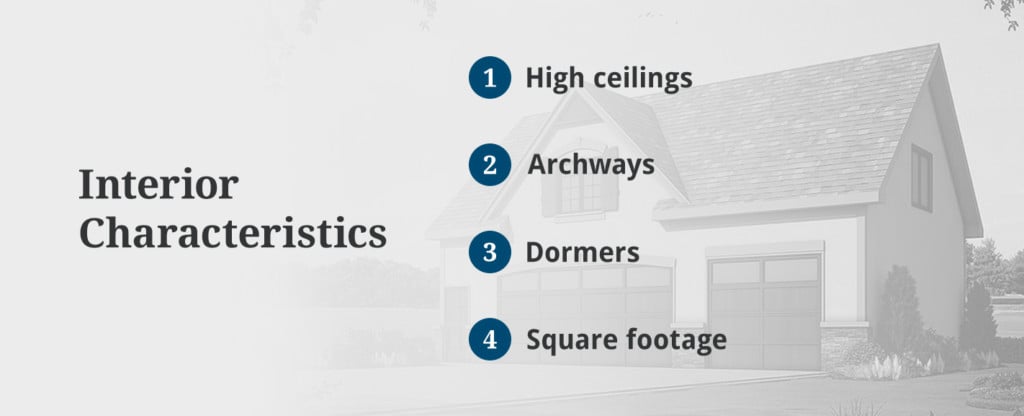
Interior Characteristics
One of the reasons carriages houses are so popular today is their interior shape. Since they were predominantly used to store vehicles, they tend to be large and spacious, often loft-like, with the added advantage of being detached and private.
They also are popular as living quarters since they are small, separate and never have a basement, so if you use your carriage house as a guest room or office, you can always rely on enjoying above-ground living.
Some other common characteristics of carriage houses include:
- High ceilings: The ground floor of original carriage houses tend to have very high ceilings with lower ceilings in the staff living quarters. Newly built carriage houses follow this design, taking advantage of the style’s loft-like feel.
- Archways: Carriage houses needed to be large enough to comfortably let a horse-drawn carriage enter, exit and be stored. Original carriage houses usually have one large archway through which the carriages would have entered and exited, with one or two smaller doors on the side for human traffic. In modern carriage houses, the high archway design is used as the entrance and exit for vehicles.
- Dormers: Since carriage houses are now best known for being detached garages with living quarters, dormer windows on the second floor are very common. These windows easily add a unique aesthetic while allowing plenty of natural light to flood the apartment.
- Square footage: Traditional carriage houses were built to cover the full width of the plot of land allotted to them. Today, the square footage for a carriage house can be anywhere from a few hundred square feet up to a thousand square feet.
Exterior Characteristics
The exterior characteristics of carriage houses tend to be more uniform and feature some or all of the following:
- Pitched roofs
- Clapboard siding
- Victorian character
- Large hinged or sliding doors
- Minimal windows
Modern carriage houses are typically available in one-, two- or three-car versions, and in keeping with the tradition of original carriage houses, usually mimic the architectural design of the main house in some way. For example, if the main house is built in the Gothic Victorian style, the carriage house would have similar coloring, trims or dormers.
Some garage apartment plans may include a patio or porch area to match the main house as well, though this is unlikely if you’re looking to build using tiny carriage house plans.
Benefits of Carriage Houses
Every home doesn’t need a carriage house, but a carriage house can always benefit a home. In addition to increasing the home’s overall resale value and curb appeal, a detached garage house offers several other benefits, including:
- Storage: While storing your vehicles is the main benefit of a carriage house, you can customize your garage house plans to include added storage rooms for other motorized vehicles, like tractors and lawnmowers. It can also be built to store all that and other items, such as seasonal equipment or gear, like skis or bicycles.
- Privacy: Since the carriage house is separate from the principal house, residents in each building can enjoy privacy and minimal noise, making it ideal as living or worker quarters.
- Space: High ceilings and ample square footage make carriage homes versatile when it comes to how you use the space. Building a separate living area on a second floor is the most common way to take advantage of the space afforded by high ceilings, but the way you use those living quarters can vary. You can make it an in-law suite or a guest room, but you could also use it as a home office or a studio.
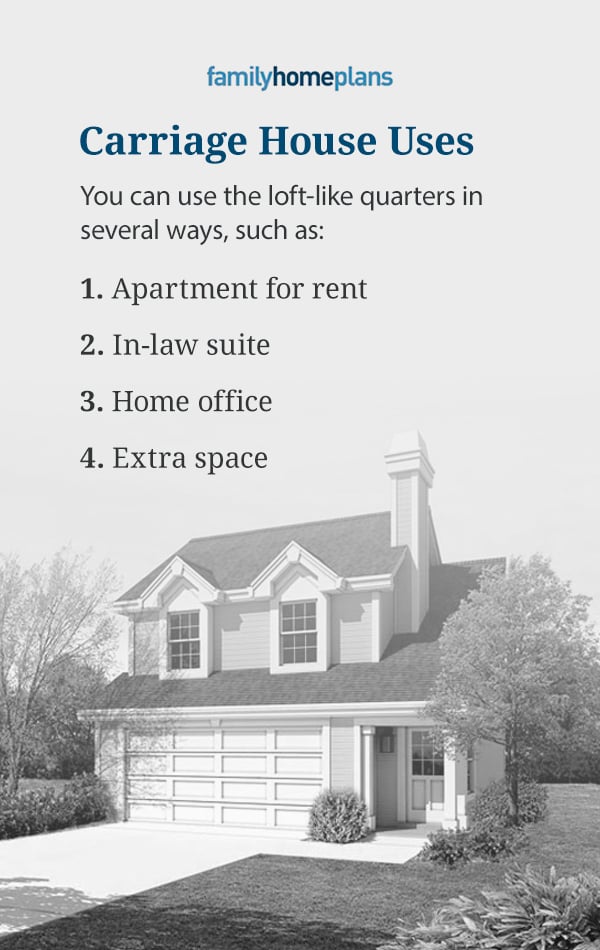
Carriage House Uses
When you build a carriage house using garage apartment floor plans, you open yourself up to a lot of potential depending on how you decide to use the extra space. You can use the loft-like quarters in several ways, such as:
- Apartment for rent: One of the most common uses of a garage apartment is to rent it out for additional income. The detached carriage house allows for ample privacy without the landlord and tenant being too far apart. The unique structure of carriage houses — being close to someone but far enough away to be private — makes them ideal homes for young families or young people who are venturing out on their own for the first time.
- In-law suite: Another popular use for carriage homes is to provide a place for aging relatives or extended family to live. Parents or in-laws who cannot live on their own for whatever reason can live with dignity in garage apartments, where they’re afforded the privacy and comfort they deserve.
- Home office: With remote working becoming more and more popular, many people use garage apartment floor plans to build themselves a separate office space where they can work with minimal distractions and still be close to home. This allows people who work from home to maintain a good work/life balance. An added advantage of this setup is home offices are often tax-deductible as well.
- Extra space: Carriage houses are also great for growing families or multigenerational families, allowing them to all live together without feeling crowded. The living spaces can also be used for personal reasons, such as hobbies or recreation. And the additional space is always an easy storage area for overflow items from the principal house.
Common Types of Carriage House Plans
Garage plans with apartments are very versatile and can be customized to your requirements. Carriage houses are the most common since they offer more space and potential for various uses. The size of the garage typically dictates how large the accompanying living quarters will be, but many modern house plans have a two-car garage, additional storage and a two-bedroom apartment with a deck and patio.
Here are some of the common types of carriage houses:
- Two-car garage carriage house: As the name suggests, a two-car garage carriage house has ample room to store up to two motor vehicles with a second story furnished with the plumbing and electrical necessities to make it a comfortable living space. While the garage size will likely remain the same for most two-car garages, the living quarters can be a recreational area with no kitchen or bathroom, a multi-bedroom apartment with a spacious living area or a spare space that can be repurposed as needed.
- Three-car garage carriage house: Three-car garage carriage houses are flexible and versatile when it comes to the upper space. The fact that a three-car garage requires more room means you can have a larger apartment on the second story or even divide up the space to include multiple additions, including a hobby room, workspace or extra storage.
When it comes to carriage house plans, the cost to build will vary based on size and design. There are almost no limitations to how you can design your carriage house. Some emphasize the interior, allowing for ample space in the common areas, while others emphasize smooth transitions from inside to outside by way of sprawling patios or second-floor decks.
Examples of Carriage House Plans
If you’re a visual person, you might find it easier to imagine how you can turn your small house plans with a garage into a detached garage apartment. There are dozens of designs and styles of carriage houses you can choose from, but here are two examples of carriage house plans to give you an idea.
Saltbox-Style 2-Story Garage Plans
This two-car garage features ample space for up to two vehicles on the main floor as well as additional storage space. The main floor also features a separate entrance that leads to a foyer and coat closet before guiding you upstairs to a spacious one-bedroom apartment.
The 687-square-foot apartment is ideal for singles or couples and comes equipped with a full kitchen, bathroom and ample space for living and eating. Two large dormer windows ensure there is plenty of natural light flooding through the apartment, and the self-contained unit also has its own little utility nook with a furnace, washer and dryer.
This simple yet efficient design is classical and aesthetically pleasing, making it ideal for renters or even for relatives or in-laws who want to age in place.
Modern-Style 3-Car Garage Plans
With room for up to three vehicles on the main floor, this three-car garage apartment measures a total of 1,190 square feet and comes with one bedroom and one-and-a-half bathrooms.
Entry to the second-level apartment is from the main floor, and the entrance features a half bathroom, closet and bench before guiding visitors up the stairs to the living quarters.
With a full kitchen and dining area, a spacious living area and a separate bedroom, this apartment is ideal for singles, couples or small families. While officially it is a one-bedroom apartment, there is ample space in the living area to create a second bedroom if needed. The space is equipped with a laundry room as well, but its most striking feature may be its second-story deck, which runs the width of the carriage house.
This carriage house also breaks from traditional carriage house designs by having many windows throughout, allowing lots of sunlight, and the balcony provides a safe and spacious area to recline and enjoy fair weather.
Carriage House Plans FAQ
Many questions often arise when people opt to use pre-fabricated floor plans to build a new home or an addition to their existing home, so here are some of the most frequently asked questions about carriage houses:
What Is a Carriage House Apartment?
Carriage house apartments — also known as coach house apartments — are the living quarters above a garage. In original carriage houses, there were often living quarters on the second floor for staff, and modern-day carriage house plans take advantage of the additional living quarters that can exist above an automobile garage.
These coach house apartments are self-contained apartments with electricity, water and heat and can be anywhere from a studio space to one or more bedrooms. These spaces are also versatile and can be used to house guests, extended family or paying renters. They can also be used as personal spaces for home offices, studio spaces or recreational areas.
Where Is the Carriage House Located?
Original carriage houses were located close to the main residence — sometimes right next door, only a few feet apart, or distinctly set apart and located up to a mile away. Modern-day carriage house apartments have no set rule when it comes to location. The size of the property and the space available will likely dictate the carriage house’s location, which could be near the rear of the property or adjacent to the main residence.
How Many Square Feet Is a 2-Car Garage?
On average, a two-car garage — excluding any second-floor living quarters — will measure between approximately 500 square feet up to 700 square feet. The average length of a two-car garage can be anywhere from 20 feet to 24 feet while the width will vary between 22 feet and 26 feet. When calculating the width, include the size of the garage door as well as any space you want for storage or other functions, like a workbench.
What Is a Coach House?
A coach house is just another term for a carriage house. While coaches and carriages may have been different vehicles, they were stored in the same house, called a coach or carriage house. The house’s name depended on what was being stored, but today, the terms are interchangeable.
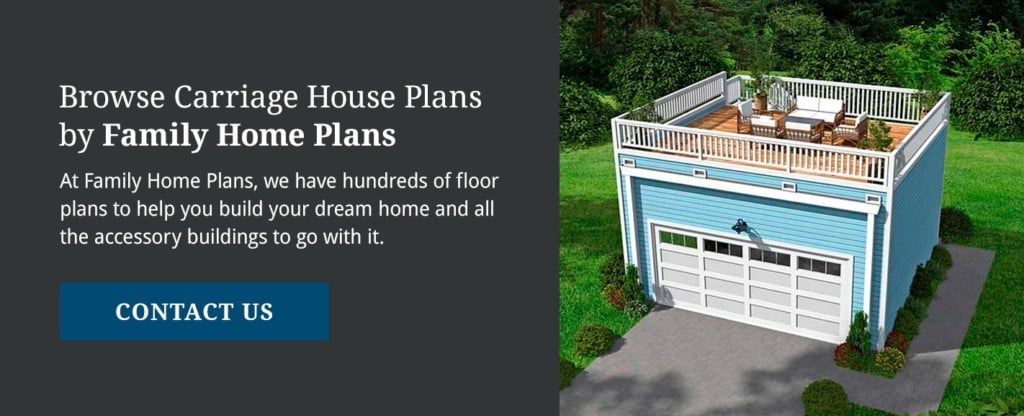
Browse Carriage House Plans by Family Home Plans
Take advantage of the freedom that comes with building your own structures using pre-existing plans. At Family Home Plans, we have hundreds of floor plans to help you build your dream home and all the accessory buildings to go with it.
Browse our selection of garage apartment plans today or, for more information, get in touch with us by calling toll-free: 1-800-482-0464.

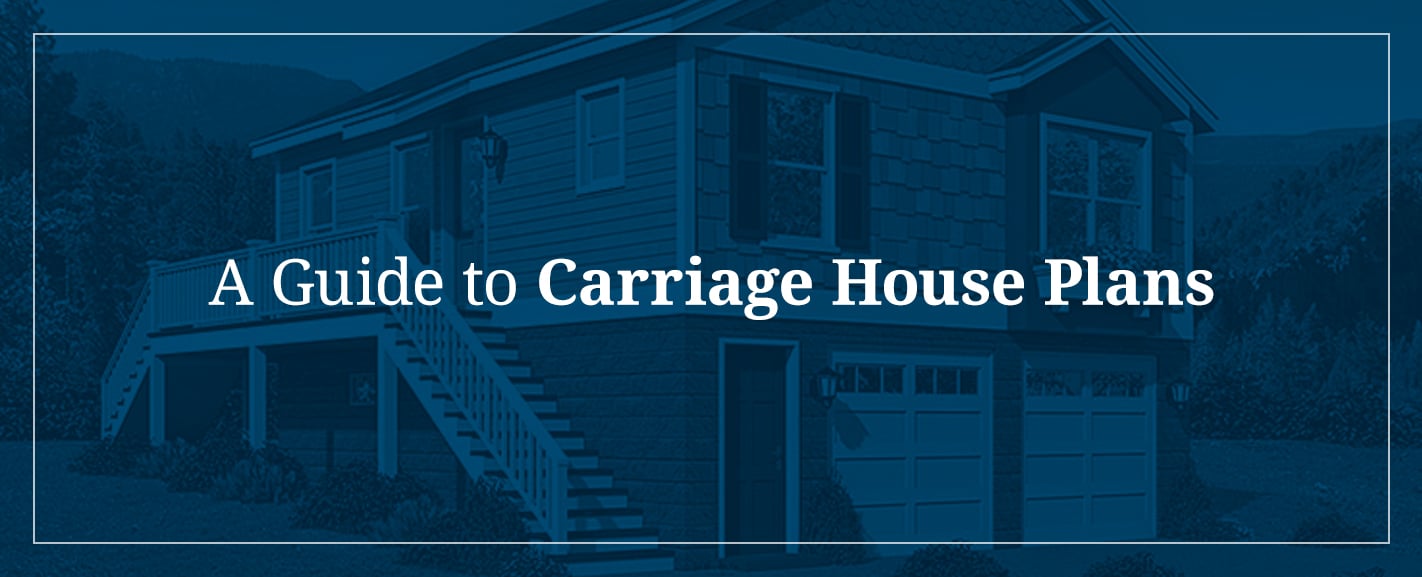

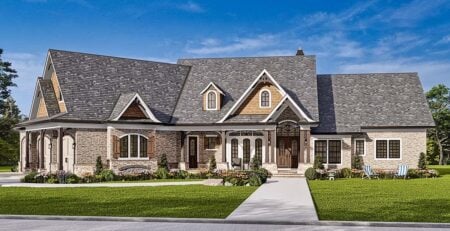
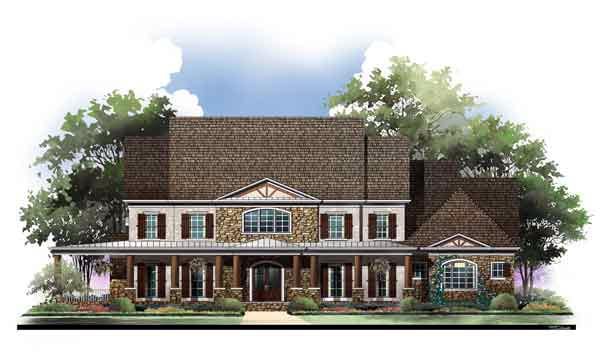
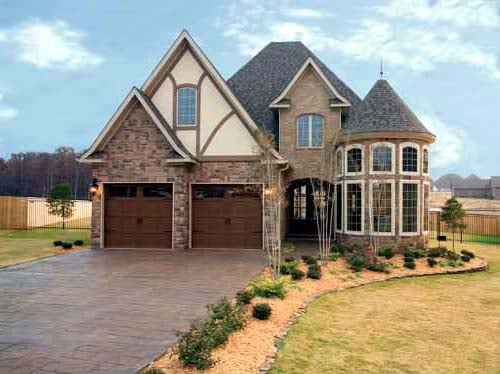
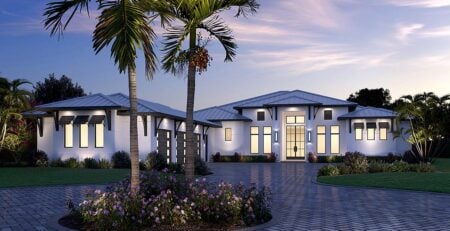

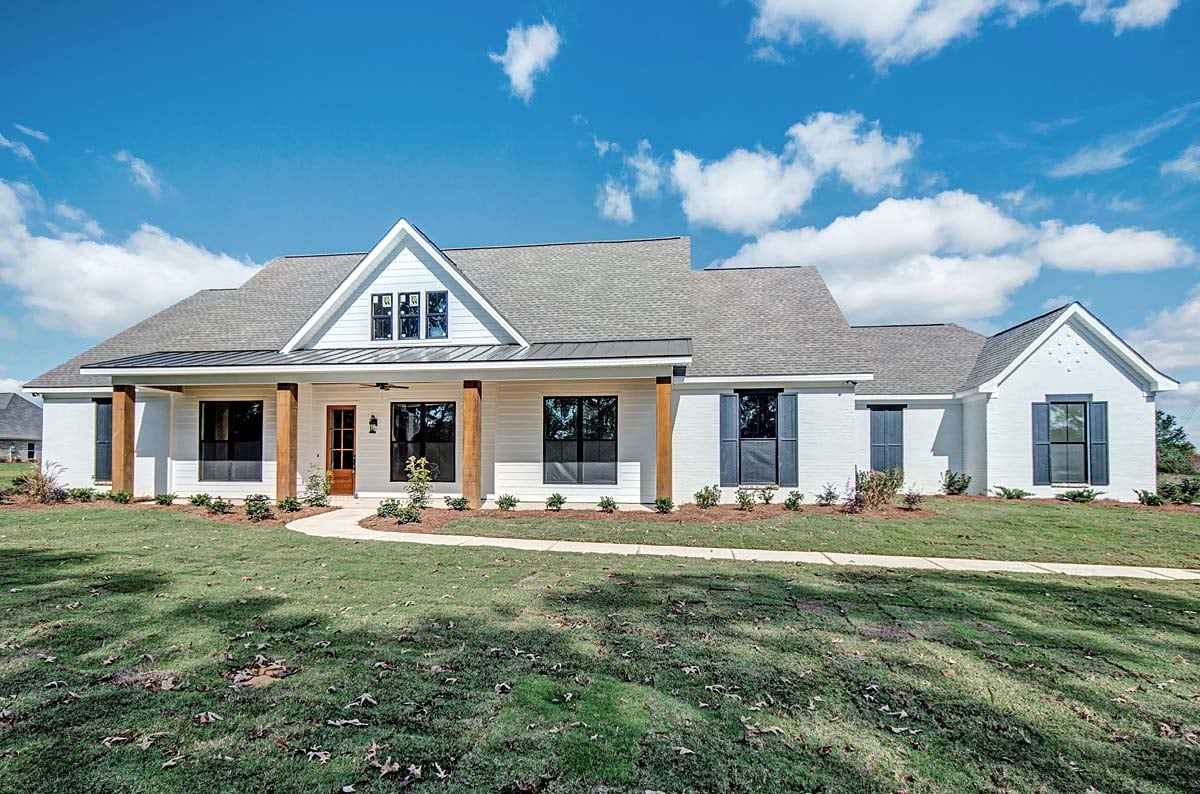
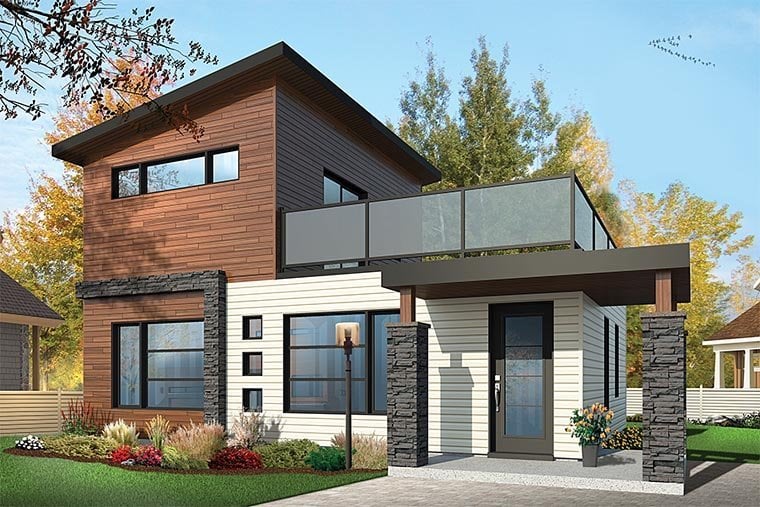

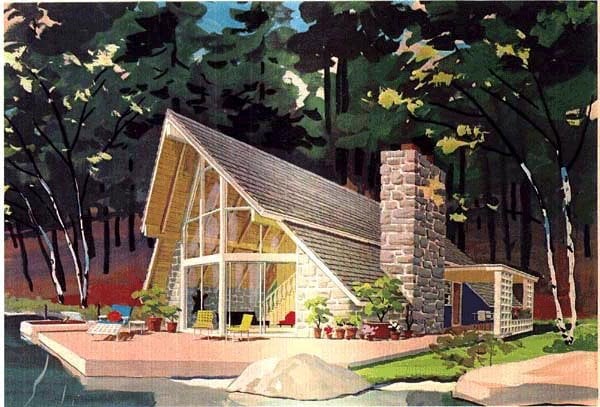

Leave a Reply